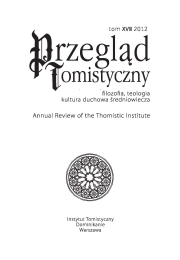Dzieła Mikołaja z Mościsk OP i teologów zachodnich źródłem pierwszego manuale dla spowiedników w języku cerkiewnosłowiańskim
The Works of Mikołaj of Mościska, O.P., And Western Theologians as Sources for the First Manual for Confessors Published in Church Slavonic
Author(s): Margarita A. KorzoSubject(s): Christian Theology and Religion, Theology and Religion, Eastern Orthodoxy
Published by: Instytut Tomistyczny
Summary/Abstract: The thesis of the decisive influence of Catholic theology on so-called Orthodox “school” theology in the Polish-Lithuanian Commonwealth in the seventeenth century has long been established in the historiography of the subject. Less attention has been paid to the genesis of specific texts of the Western tradition, which were not only a source of inspiration for writers from the Orthodox world, but were literally translated, only to be considered in later years as homegrown Orthodox works. When carrying out word-for-word translations it was necessary for Orthodox writers to develop translation techniques that could effectively ”mask” what they had borrowed. An interesting example of this sort of translation is the first handbook for confessors, entitled Mir s Bogom čeloveku (Kiev 1669), which was prepared by the Kiev Lavra archimandrite Innocenty Gizel (d. 1683). This work is mostly a compilation of three treatises by the Polish Dominican Mikołaj Mościski (1559–1632): Elementa ad S. Confessiones (1603), Examen approbandorum ad S. Confessiones excipiendas (post 1621) and S. Artis poenitentiariae tyrocinium (1625), complemented by excerpts from the Summa of Theology of Thomas Aquinas, the decree ”On justification” of the Council of Trent, the Roman Catechism, the Decree of Gratian, and various essays of the seventeenth-century Catholic moralists. Mir s Bogom was the first attempt in the Orthodox literature of the Metropolate of Kiev to present the basics of Christian teaching. It stressed the practical aspects of the faith. It was novel in its attempt to create and standardize terminology dealing with the sacraments and the doctrine of sin. The work of Gizel gained great popularity in Russia and formedthe basis for a number of manuscripts and printed manuals on how to celebrate the sacraments. Through Mir s Bogom, many fragments of the works of Western theologians were incorporated into Orthodox literature.
Journal: Przegląd Tomistyczny
- Issue Year: 2012
- Issue No: XVIII
- Page Range: 241-254
- Page Count: 14
- Language: Polish

